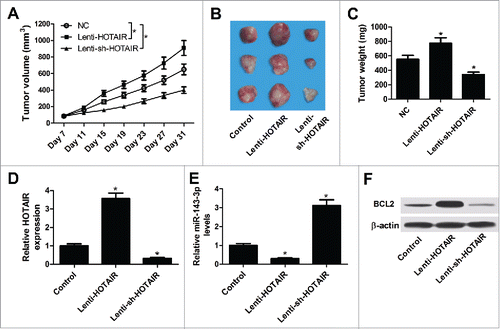Figures & data
Figure 1. The expression of HOTAIR and miR-143-3p in cervical cancer tissues and cell lines. The expression of HOTAIR (A)and miR-143-3p (B) in 22 cervical cancer tumor tissues and adjacent normal tissues. (C) The correlation analysis of HOTAIR and miR-143-3p levels in 22 cervical cancer tissues. The expression of HOTAIR(D) and miR-143-3p (E) in cervical cancer cell lines (SiHa, HeLa, Caski, c4-1) and immortalized human epidermal cells HaCaT.

Figure 2. HOTAIR stimulated the growth of cervical cancer cells. (A) HOTAIR expression levels were detected by qRT-PCR in pcDNA-HOTAIR-transfected SiHa cells and si-HOTAIR-transfected HeLa cells. (B) The effects of HOTAIR overexpression or knockdown on the proliferation activity of SiHa and HeLa cells were assessed by MTT assay. (C) The effects of HOTAIR knockdown on apoptosis of HeLa cells were detected by flow cytometry analysis. (D) The effects of HOTAIR deficiency on caspase-3 activity were measured by colorimetric assay in SiHa and HeLa cells.
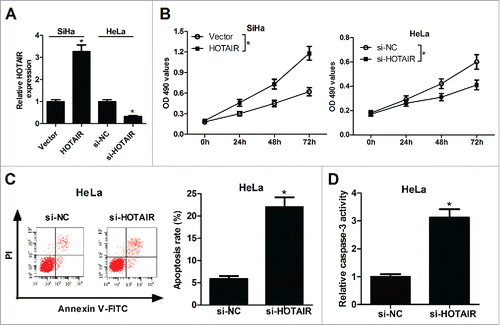
Figure 3. HOTAIR acted as a molecular sponge for miR-143-3p. (A) The predicted binding sites between miR-143-3p and HOTAIR, as well as the mutant sites in the mutant-HOTAIR luciferase vector. (B) Luciferase reporter assays were used to detect luciferase activity of SiHa or HeLa cells transfected with WT-HOTAIR or MUT-HOTAIR and (miR-NC or miR-143-3p, anti-miR-NC or anti-miR-143-3p). (C) RIP analysis was performed to assess the enrichment degree of HOTAIR and miR-143-3p by Ago2 antibody in SiHa cells. (D) qRT-PCR assay were utilized to measure miR-143-3p levels in SiHa or HeLa cells after transfected with HOTAIR or si-HOTAIR.
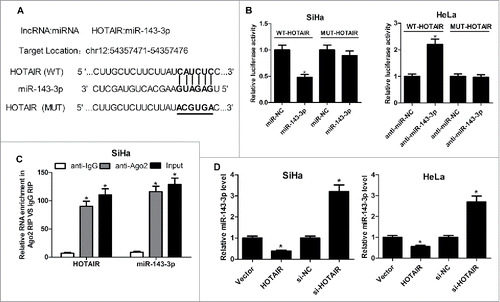
Figure 4. miR-143-3p reversed the promotion of HOTAIR on the growth of cervical cancer cells. (A) The impacts of miR-143-3p on HOTAIR-mediated pro-proliferation, as well as the effects of anti-miR-143-3p on si-HOTAIR-mediated anti-proliferation in SiHa and HeLa cells were determined by MTT assay. (B) The effect of anti-miR-143-3p on si-HOTAIR-mediated pro-apoptosis in HeLa cells was displayed by flow cytometry. (C and D) The regulatory effects of anti-miR-143-3p on BCL2 and Bax expression, as well as caspase-3 activity in si-HOTAIR-transfected HeLa cells.
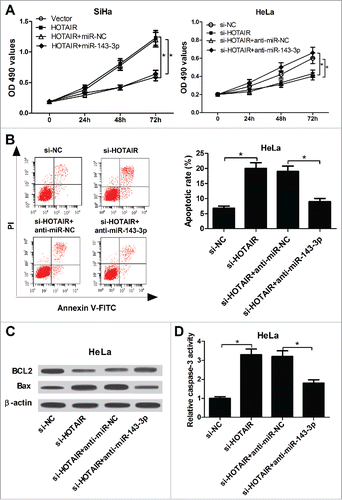
Figure 5. BCL2 was a target gene of miR-143-3p. (A) The putative binding sites between BCL2 3′UTR and miR-143-3p, and the mutation in 3′UTR of BCL2. (B) Luciferase activity analysis was performed to measure luciferase activity in SiHa and HeLa cells transfected with WT-BCL2-3′UTR or MUT-BCL2-3′UTR and (miR-NC or miR-143-3p, anti-miR-NC or anti-miR-143-3p). (C) Western blot analysis was utilized to measure BCL2 expression at protein level in miR-143-3p-introduced SiHa cells and anti-miR-143-3p-introduced HeLa cells. (D) The regulation of HOTAIR on the luciferase activity of BCL-WT reporter co-transfected with miR-143-3p in SiHa and HeLa. (E) The suppression of miR-143-3p on HOTAIR-triggered enhancement of BCL2 expression in SiHa cells and the promotion of anti-miR143-3p on si-HOTAIR-induced decrease of BCL2 expression in HeLa cells were determined by western blot assay.
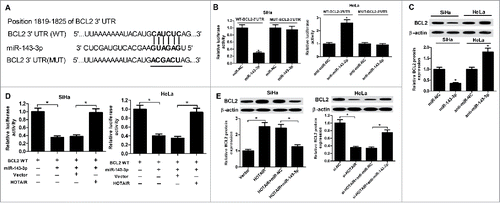
Figure 6. The inhibitory effect of BCL2 on miR-143-3p-modulated anti-proliferation and pro-apoptosis in cervical cancer cells. (A) The impact of BCL2 on miR-143-3p-induced suppression of SiHa cells proliferation, as well as the effects of si-BCL2 on anti-miR-143-3p-mediated promotion of HeLa cells proliferation were determined by MTT analysis. The effects of BCL2 on apoptosis (B), caspase-3 activity (C), as well as Bax and BCL2 expression (D) in miR-143-3p-transfected SiHa cells.
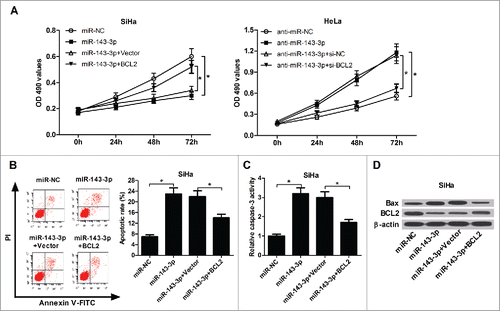
Figure 7. Effects of HOTAIR on tumor growth in vivo. (A) Tumor volumes were calculated every 4 days. (B) Representative images of resected tumor masses in different groups. (C) Tumor weights were evaluated in different groups. The expression levels of HOTAIR (D), miR-143-3p (E) and BCL2 (F) in lumps were detected by qRT-PCR or western-blot.
